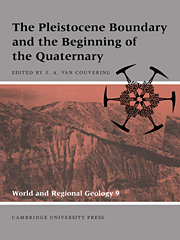Book contents
- Frontmatter
- Contents
- List of contributors
- Preface: the new Pleistocene
- Foreword
- Part I Definition of the base of the Quaternary
- Part II Characterization of the Pleistocene boundary-stratotype
- Part III The paleontological context of the Pleistocene boundary
- Part IV The Pleistocene boundary in regional sequences
- 11 The Pliocene–Pleistocene boundary in Italy
- 12 Stratigraphy of the Plio–Pleistocene sequence of the Mediterranean coastal belt of Israel and its implications for the evolution of the Nile Cone
- 13 The Pliocene–Pleistocene transition in the Iberian Peninsula
- 14 Biostratigraphy and calibrated climatic chronology of the Upper Pliocene and Lower Pleistocene of France
- 15 The Plio–Pleistocene of England and Iceland
- 16 The Neogene–Ouaternary boundary in The Netherlands
- 17 The Tertiary–Quaternary boundary in western Germany
- 18 The Pliocene–Pleistocene boundary in eastern Germany
- 19 The Plio–Pleistocene of Hungary
- 20 The Pliocene–Pleistocene boundary in Romania
- 21 The Pliocene and Pleistocene of the European part of the Commonwealth of Independent States
- 22 The N/Q boundary in Asian Russia and Tadjikistan
- 23 The Pliocene–Pleistocene boundary in the Indian subcontinent
- 24 The Pliocene–Pleistocene boundary in Japan: the Osaka Group, Kinki district
- 25 The Pliocene–Pleistocene boundary in Japan: stratigraphy in the Boso Peninsula, central Japan
- 26 The base of the Quaternary in China
- 27 Plio–Pleistocene deposits and the Quaternary boundary in sub-Saharan Africa
- 28 Plio–Pleistocene reference sections in Indonesia
- 29 The Pliocene–Pleistocene boundary in New Zealand
- 30 The Pliocene–Pleistocene boundary in continental sequences of North America
- Index
18 - The Pliocene–Pleistocene boundary in eastern Germany
Published online by Cambridge University Press: 10 November 2009
- Frontmatter
- Contents
- List of contributors
- Preface: the new Pleistocene
- Foreword
- Part I Definition of the base of the Quaternary
- Part II Characterization of the Pleistocene boundary-stratotype
- Part III The paleontological context of the Pleistocene boundary
- Part IV The Pleistocene boundary in regional sequences
- 11 The Pliocene–Pleistocene boundary in Italy
- 12 Stratigraphy of the Plio–Pleistocene sequence of the Mediterranean coastal belt of Israel and its implications for the evolution of the Nile Cone
- 13 The Pliocene–Pleistocene transition in the Iberian Peninsula
- 14 Biostratigraphy and calibrated climatic chronology of the Upper Pliocene and Lower Pleistocene of France
- 15 The Plio–Pleistocene of England and Iceland
- 16 The Neogene–Ouaternary boundary in The Netherlands
- 17 The Tertiary–Quaternary boundary in western Germany
- 18 The Pliocene–Pleistocene boundary in eastern Germany
- 19 The Plio–Pleistocene of Hungary
- 20 The Pliocene–Pleistocene boundary in Romania
- 21 The Pliocene and Pleistocene of the European part of the Commonwealth of Independent States
- 22 The N/Q boundary in Asian Russia and Tadjikistan
- 23 The Pliocene–Pleistocene boundary in the Indian subcontinent
- 24 The Pliocene–Pleistocene boundary in Japan: the Osaka Group, Kinki district
- 25 The Pliocene–Pleistocene boundary in Japan: stratigraphy in the Boso Peninsula, central Japan
- 26 The base of the Quaternary in China
- 27 Plio–Pleistocene deposits and the Quaternary boundary in sub-Saharan Africa
- 28 Plio–Pleistocene reference sections in Indonesia
- 29 The Pliocene–Pleistocene boundary in New Zealand
- 30 The Pliocene–Pleistocene boundary in continental sequences of North America
- Index
Summary
Introduction and geological background
In the late Neogene, the sea progressively retreated from wide areas of the northwestern lowlands of the North German–Polish coastal basin. Large river systems that developed in the exposed areas drained generally toward the west, laying down great amounts of fluviatile-limnic sediments. The lithology of pebbles contained in these sediments indicates that the major source area was in what is now the eastern Baltic Sea, between central Sweden and the Baltic countries. On the other hand, the presence of lydite (radiolarian chert) demonstrates that some material was also derived from the south, primarily the Bohemian Massif (Hucke, 1928; Ahrens et al., 1968; Duphorn et al., 1973; Ahrens and Lotsch, 1976). In the southern parts of Thuringia, in the area of the Thiiringer Wald, there was limited late Neogene sedimentation in subsident areas (Figure 18.1).
Northern lowlands and northeastern region
In the northern lowlands, Lower Pliocene terrestrial deposits appear to have been extensive, but only in southwestern Mecklenburg have erosion relicts been preserved. As far as we know, deposits of Plio–Pleistocene transitional series can be found only in the southwestern parts of this area (Ahrens et al., 1968).
The best-known locality of this type is Rüterberg, where the lower horizons of the sequence (Bergton-Diatomit-Silbersand complex) are followed discordantly by the Loosener Kiese (Gehl, 1958; von Bülow, 1964), a unit characterized by a mixture of “southern” pebbles (Kieselschiefer, etc.) and silicified rocks and intensely weathered granite from the north. The Bergton-Diatomit-Silbersand complex was formerly correlated by Krutzsch (1959) to the Reuverian or a still earlier stage on the basis of pollen, but more recently this unit has been correlated with the Upper Miocene (Lotsch, 1981; Krutzsch, 1988).
- Type
- Chapter
- Information
- The Pleistocene Boundary and the Beginning of the Quaternary , pp. 201 - 205Publisher: Cambridge University PressPrint publication year: 1996



